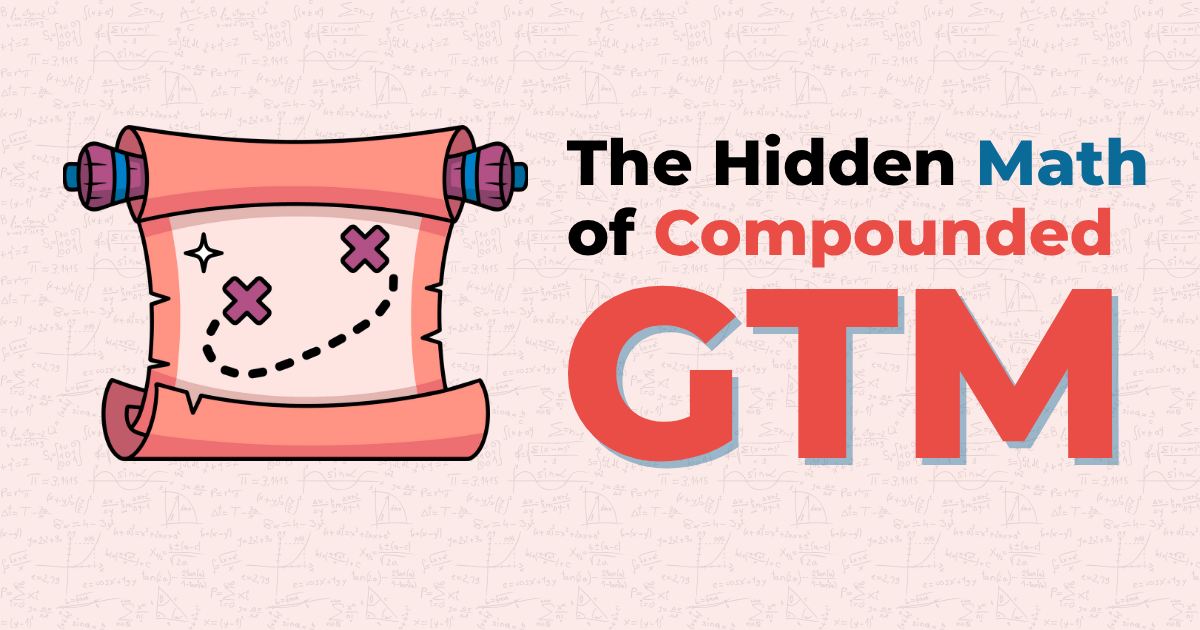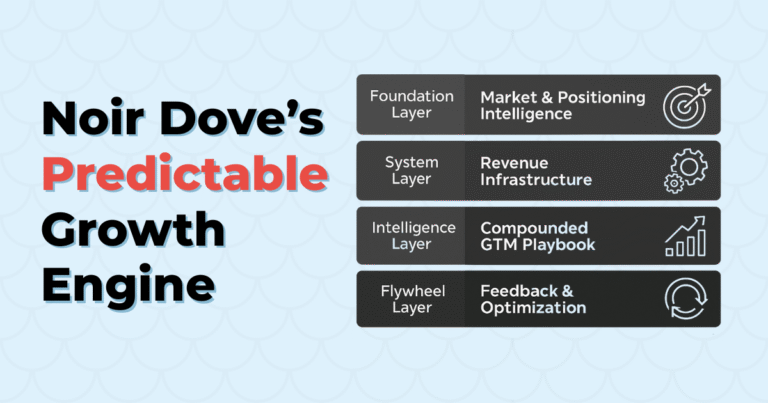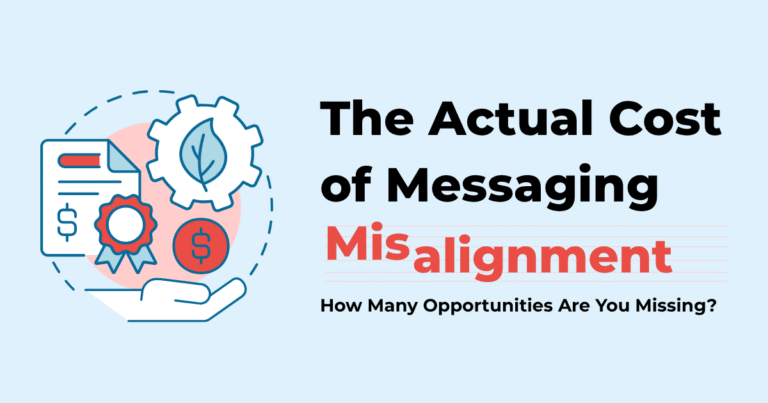Key Takeaways
- A compounded GTM system builds momentum, which multiplies over time, while one-off GTM activities do not.
- Founders often stall growth because their GTM resets after every campaign.
- A Compounding GTM connects marketing, sales, and product into one continuous growth loop.
- Founders who skip Compounding GTM lose efficiency, brand recall, and long-term revenue leverage.
- The payoff: steady pipeline, lower CAC, and freedom from constant rework.
Why Most GTM Motions Plateau
Most founders start their GTM journey with energy and urgency. The first campaigns land a few deals. The funnel looks alive. But, after six months, growth slows. The product is still solid; the market still needs it, and the team still works hard.
So what went wrong? The problem is not the effort, it’s the system.
Most startups run simple GTM motions: they push one campaign at a time, measure the short-term success of it, and move to the next one. Every month starts from zero.
A compounded GTM, however, builds on what came before. Each campaign feeds the next. Every touchpoint strengthens brand memory. And every insight will make the next play more efficient.
That’s what separates the founders chasing growth from those engineering it.
Simple GTM vs. Compounded GTM
| Aspect | Simple GTM | Compounded GTM |
|---|---|---|
| Goal | Generate leads quickly | Build sustainable, predictable growth |
| Approach | One campaign at a time | Interconnected system of marketing, sales, and product |
| Learning | Campaigns measured in isolation | Data and feedback looped into future activity |
| Team Behavior | Siloed | Cross-functional rhythm |
| Outcome | Short-term spikes | Long-term compounding ROI |
Results from HubSpot’s 2024 State of Marketing Report show that companies running integrated GTM systems drive pipeline efficiency 2.3x higher than for those running isolated campaigns.
That’s the hidden math: small actions, times multiplied over time, beat large one-off bursts.
The Cost of Non-Strategic GTM
In fact, OpenView’s 2024 SaaS Benchmarks reports that 68% of founders say repeatable pipeline generation is their biggest growth challenge after hitting $1M ARR. CB Insights cites “poor go-to-market execution” as a top-3 cause of startup failure.
Why? Because most founders rely on short-term campaigns, not compounding systems.
If you don’t build a Compounded GTM, you pay the price in ways that compound negatively:
- Wasted ad spend: each campaign starts from scratch.
- Slower sales cycles – sales has to re-educate every prospect.
- High CAC: Your cost per lead continues to increase.
- Poor brand recall: Over time, the competitors gain more attention.
- Lost leverage: Your GTM doesn’t learn; it resets.
In fact, McKinsey’s 2023 SaaS Benchmark study found that startups with Compounding GTM systems hit $10M ARR almost 2 years faster than those relying on campaign-based marketing.
That’s the opportunity cost: Not just lost deals, but lost acceleration.
The Mechanics of Compounding GTM
A Compounding GTM works like compound interest: your past effort keeps paying dividends.
How Growth Compounds
| Stage | Focus | Output | Compounding Effect |
|---|---|---|---|
| Learn | Capture insights from every GTM motion | Clear ICP and refined narrative | Reduces wasted effort |
| Align | Sync marketing, sales, and product around shared goals | Consistent buyer experience | Improves conversion velocity |
| Scale | Automate and amplify what works | Predictable revenue flow | Growth compounds with time |
Every cycle makes the next easier, cheaper, and faster.
That’s the power of system memory — your GTM learns.
Signs Your GTM Isn’t Compounding
- Each campaign is like starting over.
You will always be creating new content without reuse or connection. - Leads come in bursts, not in flow.
Growth depends on activity, not momentum. - Marketing and sales are not aligned.
One talks about features, the other about pain points. - Your data sits unused.
You collect the numbers but don’t apply any learnings to the next cycle. - You’re stuck in founder-led growth.
Everything works only when you push it yourself.
If any of those sound familiar, your GTM is simple-not compounded.
The Time Horizon of Compounded GTM
A Compounding GTM doesn’t work overnight. It compounds over cycles:
- Month 1–3: System design, ICP clarification, sales and marketing alignment.
- Month 4–6: Feedback loops improve targeting and message resonance.
- Month 7–12: Brand equity, data, and systems begin to compound pipeline growth.
Think of it as a flywheel, not a faucet. Once momentum starts, it takes less effort to sustain and scale.
How Founders Can Start Building Compounding GTM
- Audit what already exists.
Map all the touchpoints where marketing, sales, and product intersect. Identify gaps and overlaps. - Create one common rhythm for GTM.
Align messaging, cadence of content, and funnel goals among teams. - Focus on consistency, not intensity.
Posting once a week for a year beats posting daily for a month. - Build learning loops.
After every campaign, ask: what can we automate, reuse, or improve next time? - Automate repetition.
Use tools for what’s predictable. Save people for what’s creative. - Measure what compounds.
Track LTV/CAC ratio, conversion velocity, and content reuse rate-not vanity metrics.
Compounding versus Non-Compounding Metrics
| Non-Compounding GTM | Compounded GTM |
|---|---|
| ROI changes monthly | ROI improves steadily |
| High volume, low quality leads | Lower volume, higher intent |
| Revenue depends on founder push | Revenue grows from system pull |
| Ad spend resets every quarter | Organic and referral leads rise |
| No brand recall | Brand trust compounds |
According to Gartner’s 2024 CMO Leadership Report, companies with integrated GTM feedback loops grow 33% faster and achieve 21% higher ROI.
That’s the measurable difference between growth and grind.
Mini Case Example
A cloud security startup has seen nine months of inconsistent growth. Their campaigns looked good in reports but didn’t compound results.
By aligning messaging, redefining ICPs, and syncing content with sales enablement, they doubled their MQL-to-SQL rate in 90 days, without adding new spend. The secret wasn’t doing more; it was making each motion feed the next.
A Founder’s Reflection
Before you launch your next campaign, ask yourself:
- Is this building on something we already created?
- Will it make the next campaign easier or cheaper?
- Is my team aligned on what success looks like?
- Am I compounding or just repeating?
If you can answer “yes” to the first two, you’re already building leverage.
The Founder’s Payoff
The real payoff of Compounding GTM is not just pipeline. Freedom from chaos, from hustle, from the constant restart. When your GTM compounds, you stop chasing growth and start engineering it. You stop reacting to market shifts and start shaping them. Growth becomes math rather than magic.
Frequently Asked Questions (FAQs)
1. What is a Compounded GTM system?
It’s an interconnected system in which marketing, sales, and product feed into and build on one another to create predictable, repeatable growth.
2. How is Compounded GTM different from regular GTM?
Regular GTM relies on separate campaigns, whereas Compounded GTM makes every action build momentum for the next.
3. How long does it take to see results?
In general, Founders see steady improvement in 3–6 months as the alignment and learning loops start compounding.
4. Can early-stage startups use Compounding GTM?
Yes, the earlier you start, the faster your systems learn and multiply results.
5. What’s the biggest mistake founders make with GTM?
They focus on speed over structure-launching campaigns before building the systems that will connect them.




